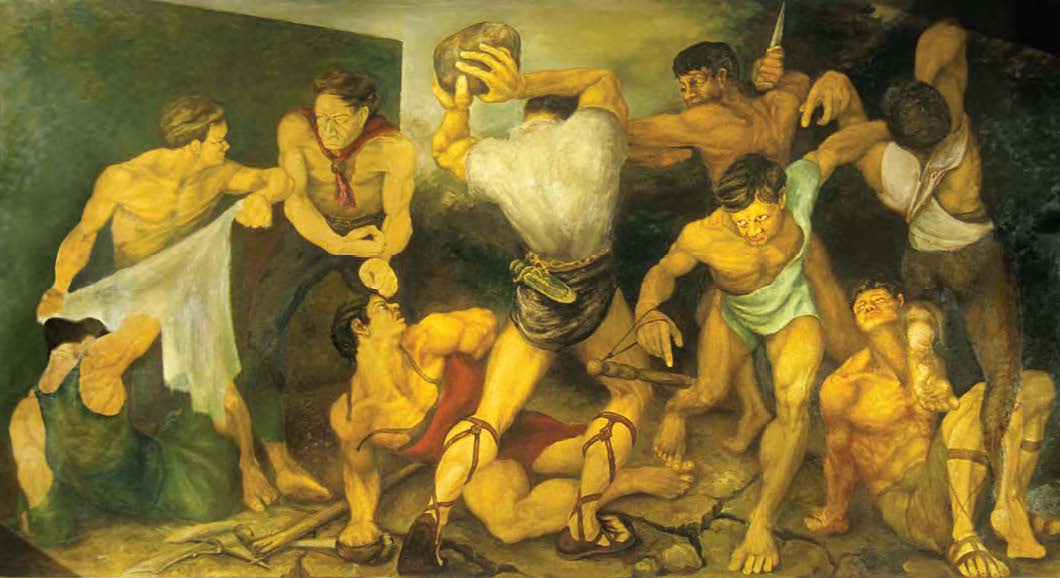There are street scenes in a marketplace, beggars imploring help, soldiers strolling and talking with young women, and children and adults engaged in the activities of life. The most imposing scene shows nine scantily clad, muscular men fighting with their fists and crude weapons. Looking at this large painting, you get the sense that this raging scene portrays a desperate struggle rather than hatred and orchestrated violence.
The Fort McClellan Officers’ Club was constructed in 1936—originally built as officers’ quarters. Around 1940 it evolved into a full-service club that held numerous social functions, military balls, entertainment, and banquets. One can only imagine the conversations of the thousands of people who viewed these murals and wondered about their origins.
Fort McClellan was the site of a major POW camp in Alabama, holding over thirty-five hundred German and Italian POWs from 1943 until 1946. Because the facility was closed after WWII and not reopened until just prior to the Korean War, scant records exist to tell us the history of this period of time, including the story of the murals.
It was always known that POWs painted the murals, but very little factual information about either the artists or their techniques surfaced until 1998. At that time, the U.S. Army contracted with paintings conservator Catherine Gambrell Rogers of Charleston, South Carolina, to treat and restore the murals. This action—coordinated through the Alabama Historical Commission—followed the guidelines of the Defense Base Closure and Realignment Act. This act specifies that historic properties located on military installations identified for closure must be restored and/or renovated prior to closure.
Signatures found during this restoration revealed that these murals were painted in 1945 by Albin Sagadin and Herbert Belau. An Army Reserve captain with a keen interest in the murals enlisted the help of his German wife to locate Sagadin, Belau, or their descendants. She had no luck finding Belau, but Sagadin being an unusual name in Germany, she located an “A. Sagadin” in the national phone directory.
learned that this “A. Sagadin” was indeed the POW artist. Unfortunately, Sagadin had died just a few months earlier at age eighty-four. According to Maria, his widow, Sagadin was twenty-six years old and a student at the Dresden Academy of the Arts before becoming an officer in Rommel’s Afrika Corps. He was captured by the U.S. Army in Tunisia in 1944 and subsequently sent to Fort McClellan to wait out the war.
Maria said that her husband often spoke of his time at McClellan. Like many of the POWs housed in U.S.– based camps, he had sentimental memories of those days and wanted to go back to Alabama. In fact, he even sought American citizenship while a prisoner but a “lung sickness” prevented it. When he returned to Germany, he worked as a salesman, but he continued to paint whenever he could and often refused to sell his paintings. The walls of his home are covered in his works.
In late 1999 a copy of the report of restoration was sent to the curator of the U.S. Army military museum in Wurzburg with a request to present it to Maria Sagadin. By a fortuitous coincidence, museum curator Gabriele Torony knew all about the murals. Born in Frankfurt to a German mother, Torony is nevertheless an American citizen. Her father was a non-commissioned officer at Fort McClellan. Torony eventually worked at the base too, where she became quite familiar with the murals and the mystery. She moved to Wurzburg in 1989 to work in the military museum, and it would be her privilege to honor Sagadin’s contribution to American history.
Torony invited the local media and the U.S. military newspaper, Stars and Stripes, to observe as she presented the restoration report to Maria Sagadin and her daughter, Carmen. Both were rather overcome by the event—proud, to be sure, but also sad that Albin Sagadin died without knowing his work had survived and was being admired by so many.
After Fort McClellan closed as an active military post in 1999, the properties were offered for sale to the public. The Officers’ Club was purchased and, after extensive remodeling, became an event center and restaurant. Because of the paintings and the historic district where the building is located, certain agreements or covenants in the property deed required the protection of the murals.
The owner passed away last year, leaving the property to his son, who listed it for sale. The work of Sagadin and Belau has now been inaccessible to the public for a few years, generating perpetual concern in the Anniston community. Rumors repeatedly surface that the murals are threatened by mold and moisture damage. As long as the structure holding this treasure remains locked and empty, fears will grow. But the recent news that the property has been purchased for an events center brings a glimmer of hope that the murals will once again be enjoyed by the public and preserved for the future.
For over fifty years, the U.S. Army protected and maintained these works of art without knowing who painted them or what story, if any, they portrayed. Now we know that they are far more than simply stunning paintings or nostalgic relics of the old Officers’ Club. They are a vivid representation of a fi ne hour in the American past—when prisoners were treated with such humanity, they were inspired to create a gift that outlived them. The fate of that gift is our collective concern.
This feature was previously published in Issue 94, Fall 2009.
About the Authors
Joan McKinney was the Director of Protocol and Community Outreach Coordinator at Fort McClellan for 12 years and has an extensive collection of McClellan POW records. Direct comments to joanmck@earthlink.net.
Robert Gamble, senior architectural historian for the Alabama Historical Commission, serves as the standing editor of the “Southern Architecture and Preservation” department of Alabama Heritage.

 RSS Feed
RSS Feed